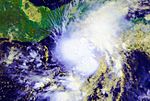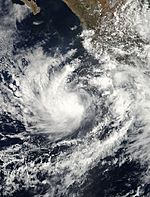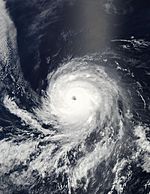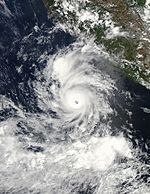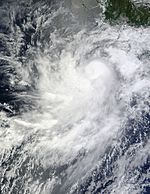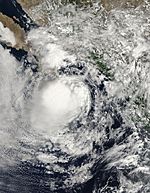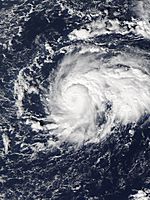2010 Pacific hurricane season facts for kids
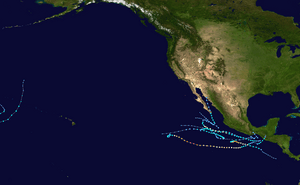 |
|
| Season summary map | |
| First storm formed | May 29, 2010 |
|---|---|
| Last storm dissipated | December 21, 2010 |
| Strongest storm | Celia – 921 mbar (hPa) (27.21 inHg), 160 mph (260 km/h) |
| Total depressions | 13 |
| Total storms | 8 |
| Hurricanes | 3 |
| Major hurricanes (Cat. 3+) | 2 |
| Total fatalities | 195+ |
| Total damage | $1.62 billion (2010 USD) |
| Pacific hurricane seasons 2008, 2009, 2010, After-2010 |
|
The 2010 Pacific hurricane season was a time when tropical storms and hurricanes formed in the Pacific Ocean. This season officially started on May 15, 2010, for the eastern Pacific and June 1, 2010, for the central Pacific. It ended on November 30, 2010. These dates are when storms are most likely to happen.
This season was not very busy, with fewer storms than usual since 1977. The first storm, Tropical Storm Agatha, formed about two weeks earlier than the first storm in 2009. During this season, there were 13 tropical depressions, which are weak storms. Out of these, 8 became tropical storms, and 3 grew into hurricanes. One of these hurricanes, Celia, became a very powerful Category 5 hurricane.
Tropical Storm Agatha caused a lot of damage and sadly led to the deaths of at least 196 people in Central America. Other storms in this season did not affect land as much.
Contents
- Storms of the 2010 Pacific Hurricane Season
- Tropical Storm Agatha: A Dangerous Start
- Tropical Depression Two-E: Rain and Flooding
- Tropical Storm Blas: Staying Out at Sea
- Hurricane Celia: A Rare Category 5 Storm
- Hurricane Darby: Another Strong Hurricane
- Hurricane Frank: A Category 1 Hurricane
- Tropical Storm Georgette: A Late Season Storm
- Tropical Storm Omeka: The Last Storm
- Storm Names
- Images for kids
- Related Pages
- See also
Storms of the 2010 Pacific Hurricane Season
Tropical Storm Agatha: A Dangerous Start
| Tropical storm (SSHS) | |||
|---|---|---|---|
|
|||
| Duration | May 29 – May 30 | ||
| Intensity | 45 mph (75 km/h) (1-min), 1001 mbar (hPa) | ||
The first storm of the season, Agatha, began as a "tropical disturbance." This is like a cloudy, rainy area that can grow into a storm. On May 29, it became Tropical Depression One-E. It quickly got stronger and was named Tropical Storm Agatha.
Agatha moved towards land and reached its strongest point with winds of 45 miles per hour (75 km/h). It made landfall near the border of Mexico and Guatemala. After moving over land, Tropical Storm Agatha quickly weakened and disappeared on May 30. This storm caused about 146 deaths in Central America.
Tropical Depression Two-E: Rain and Flooding
| Tropical depression (SSHS) | |||
|---|---|---|---|
|
|||
| Duration | June 16 – June 17 | ||
| Intensity | 35 mph (55 km/h) (1-min), 1007 mbar (hPa) | ||
Tropical Depression Two-E formed on June 16 from a "tropical wave." It moved close to the coast of Mexico. Its winds reached about 30 miles per hour (45 km/h), which was not strong enough to be called a tropical storm.
This depression stayed off the coast and disappeared on June 17. Even though it wasn't a strong storm, its rains caused flooding. About 82 houses were damaged, and 40 others were affected. Some people even lost their roofs because of strong winds. Luckily, no one was killed by Tropical Depression Two-E.
Tropical Storm Blas: Staying Out at Sea
| Tropical storm (SSHS) | |||
|---|---|---|---|
|
|||
| Duration | June 17 – June 21 | ||
| Intensity | 65 mph (100 km/h) (1-min), 994 mbar (hPa) | ||
On June 17, Tropical Depression Four-E started from an area of low pressure. It quickly became Tropical Storm Blas just one hour later. Blas grew into a strong tropical storm, with its highest winds reaching 65 miles per hour (100 km/h) on June 19.
As it moved into colder waters, Blas slowly weakened. The next day, it became a tropical depression again and disappeared on June 21. Tropical Storm Blas stayed far away from land, so it did not cause any problems.
Hurricane Celia: A Rare Category 5 Storm
| Category 5 hurricane (SSHS) | |||
|---|---|---|---|
|
|||
| Duration | June 18 – June 28 | ||
| Intensity | 160 mph (260 km/h) (1-min), 921 mbar (hPa) | ||
Celia formed on June 19 and quickly became a tropical storm, then a hurricane. On June 21, it became a Category 2 hurricane. By June 23, it strengthened to a Category 3 hurricane for a short time.
After facing some difficult weather conditions, Celia weakened. But then, when conditions improved, it got stronger again. On June 24, Celia became a powerful Category 5 hurricane, making it the strongest storm of the season. However, Celia then moved into an area with dry air, which made it weaken very quickly. It soon became a tropical storm again before completely disappearing. Celia was far from land, so it did not cause any damage.
Hurricane Darby: Another Strong Hurricane
| Category 3 hurricane (SSHS) | |||
|---|---|---|---|
|
|||
| Duration | June 23 – June 28 | ||
| Intensity | 120 mph (195 km/h) (1-min), 959 mbar (hPa) | ||
Hurricane Darby formed on June 23 and quickly gained strength. It became a Category 3 hurricane, which is a major hurricane. Darby moved across the Pacific Ocean for several days. It eventually weakened and disappeared on June 28. Like Celia, Darby stayed far from land and did not cause any harm.
Hurricane Frank: A Category 1 Hurricane
| Category 1 hurricane (SSHS) | |||
|---|---|---|---|
|
|||
| Duration | August 21 – August 28 | ||
| Intensity | 90 mph (150 km/h) (1-min), 978 mbar (hPa) | ||
Hurricane Frank formed on August 21. It became a Category 1 hurricane, with winds strong enough to cause some damage if it hit land. Frank lasted for about a week, moving across the ocean. It weakened and disappeared on August 28. Frank also stayed away from populated areas.
Tropical Storm Georgette: A Late Season Storm
| Tropical storm (SSHS) | |||
|---|---|---|---|
|
|||
| Duration | September 20 – September 23 | ||
| Intensity | 40 mph (65 km/h) (1-min), 999 mbar (hPa) | ||
Tropical Storm Georgette formed late in the season, on September 20. It was a weaker tropical storm, with winds of 35 miles per hour. Georgette lasted for a few days before it weakened and disappeared on September 23. It did not affect any land areas.
Tropical Storm Omeka: The Last Storm
| Tropical storm (SSHS) | |||
|---|---|---|---|
|
|||
| Duration | December 18 – December 21 | ||
| Intensity | 50 mph (85 km/h) (1-min), 997 mbar (hPa) | ||
Tropical Storm Omeka was the very last storm of the 2010 Pacific hurricane season. It formed on December 18, well after the official end date of the season. Omeka was a tropical storm with winds of 45 miles per hour. It lasted for a few days and disappeared on December 21.
Storm Names
Tropical storms and hurricanes are given names to make them easier to identify and track. Here are the names used for storms that formed in the East Pacific in 2010. Names that were not used are shown in a special way. This list was also used in the 2004 season.
|
|
|
For the central Pacific Ocean, a different set of names is used. A central Pacific name is given if a named storm starts near Hawaii. Here are the names that were available for that region:
|
|
Images for kids
Related Pages
See also
 In Spanish: Temporada de huracanes en el Pacífico de 2010 para niños
In Spanish: Temporada de huracanes en el Pacífico de 2010 para niños


